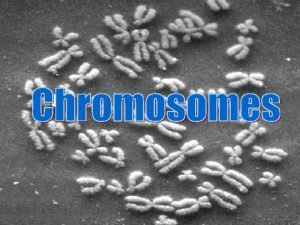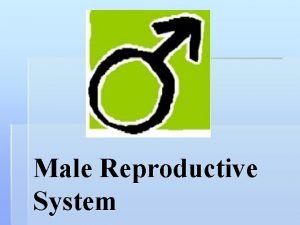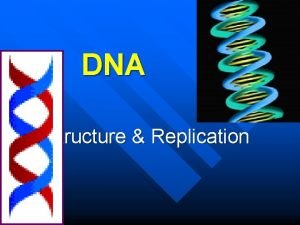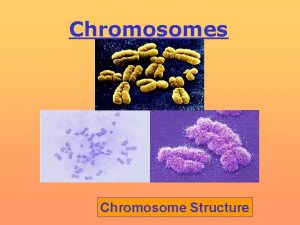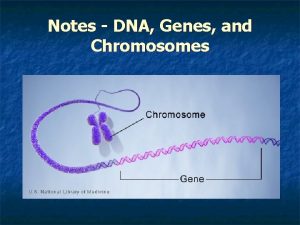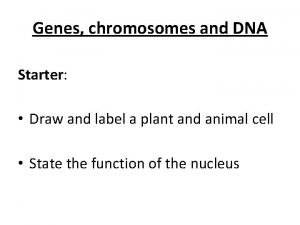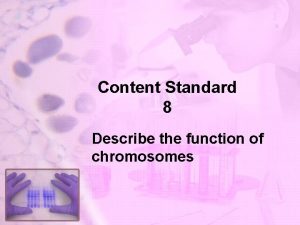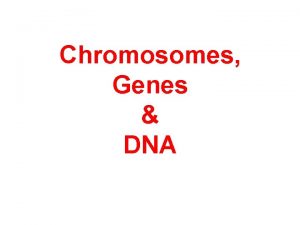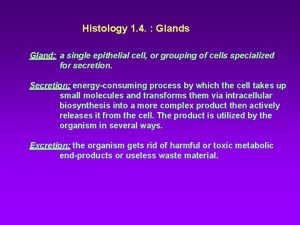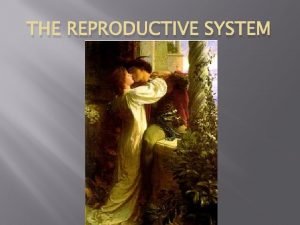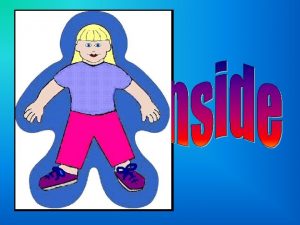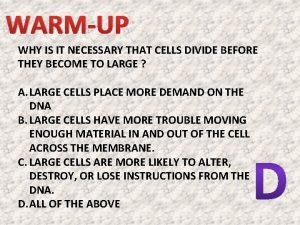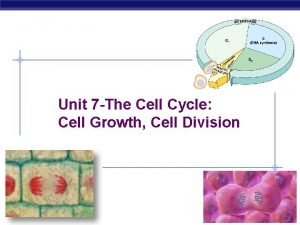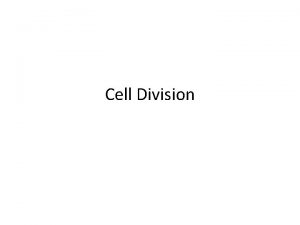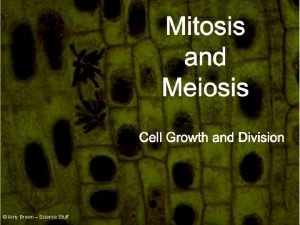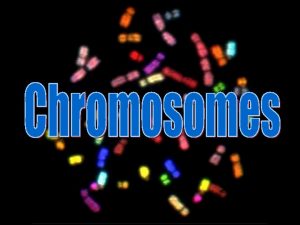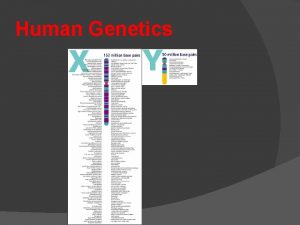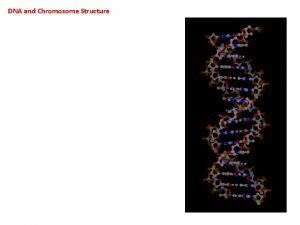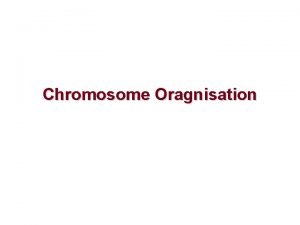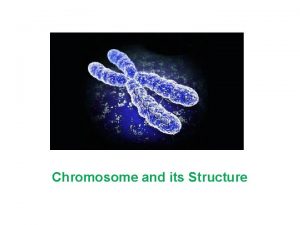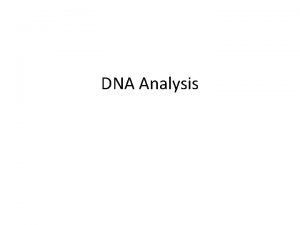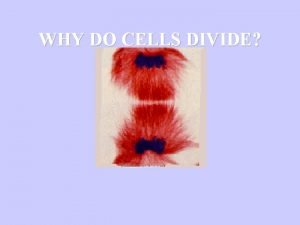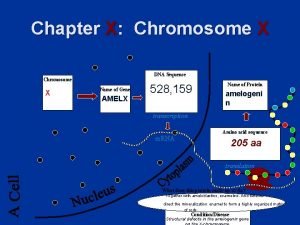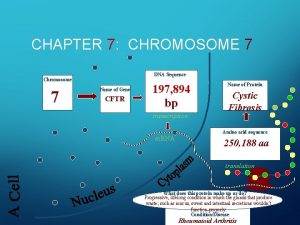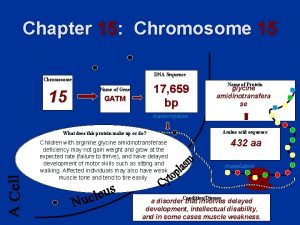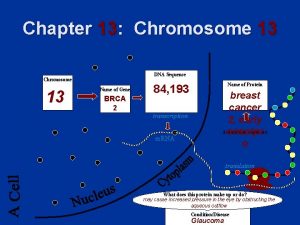Chromosome Tightly coiled DNA Form when cells divide

















- Slides: 17

Chromosome: Tightly coiled DNA • Form when cells divide – Chromosomes created for the new cells • 2 Parts: – 1) Chromatids: two identical parts of a chromosome – 2) Centromere: Joins chromatids together

Identifying chromosomes Chromosomes can be identified by: • Their size • Their shape (the position of the centromere) NB Chromosomes are flexible • Banding patterns produced by specific stains (Giemsa) Chromosomes are analysed by organising them into a KARYOTYPE © 2007 Paul Billiet ODWS © Biologyreference. com

• Defined: Picture of an individuals chromosomes – Help identify sex & chromosome defects • First 22 pairs = autosomes • Size of final pair identifies sex – Same size: XX = female – Different size: XY = male • Normal human will have 46 chromosomes

Numbers of chromosomes • Constant for each cell in the body except sex cells which only have half sets • Constant throughout the life of an individual (you don’t lose or gain chromosomes) • Constant for all members of a species – Humans have 46 chromosomes – Chimpanzees have 48 – Maize (corn) has 20 © 2007 Paul Billiet ODWS

• Diploid Cells = Cells with the full set of chromosomes – Paired chromosomes • Half of our chromosomes come from each parent (23 from each parent) • Somatic (non-sex) cells are diploid • Created by mitosis • Ex: Skin, Muscle, Nerve, Blood Cells

• Haploid Cells = Cells with ½ the total number of chromosomes • Gametes (sex cells) are the only haploid cells – Ex: Sperm, Egg, Pollen • Created by meiosis – Chromosome number reduced by 1/2 How do humans get 46 chromosomes? Haploid sperm cell (23) + Haploid egg cell (23) = Diploid zygote (46)

Chromosomes in eukaryotes and prokaryotes are different PROKARYOTES EUKARYOTES single chromosome plus plasmids many chromosomes circular chromosome linear chromosomes made only of DNA made of chromatin, a nucleoprotein (DNA coiled around histone proteins) found in cytoplasm found in a nucleus copies its chromosome and divides immediately afterwards copies chromosomes, then the cell grows, then goes through mitosis to organise chromosomes in two equal groups © 2007 Paul Billiet ODWS

Chromosomes in eukaryotes • Found in the nucleus • Condensed and visible during cell division • At the beginning of mitosis they can be seen to consist of two threads (sister chromatids) joined by a centromere • The sister chromatids are identical copies • During mitosis the sister chromatids separate and are placed into two nuclei © 2007 Paul Billiet ODWS Image believed to be in the Public Domain

Chromosomes and cell division • Multicellular organisms copy their chromosomes before cell division. • They must grow to a mature size. Interphase • The nucleus divides, distributing the chromosomes into two equal groups (mitosis). • The cytoplasm then divides (cytokinesis) each part taking a nucleus. © 2007 Paul Billiet ODWS Image believed to be in the Public Domain

The cell cycle Some cells may stay in this stage for over a year Cytokinesis Division of the cytoplasm M G 0 G 1 G 2 First growth phase. Varies in length Second growth phase S G 1 + S + G 2 = INTERPHASE © 2007 Paul Billiet ODWS Copying of chromosomes

The cell cycles in different cells Cell type Bean root tip Cell cycle / hours 19. 3 Mouse fibroblast 22 Chinese hamster fibroblast Mouse small intestine epithelium 11 Mouse oesophagus epithelium © 2007 Paul Billiet ODWS 17 181

How many chromosomes are in brain cells? Remember…Brain cells are non-sex cells… …Somatic cells are diploid… …Diploid cells have the full set of chromosomes Answer = 46

What is the human haploid chromosome number? Remember…Haploid = half number of chromosomes Answer = 23 chromosomes

How many chromosomes are in female egg cells? Remember…Egg cells are sex cells… …Sex cells are gametes… …Gamete cells are haploid… …Haploid cells have ½ the set of chromosomes Answer = 23

What is the human diploid chromosome number? Remember…Diploid = total number of chromosomes Answer = 46

What is the human gamete chromosome number? Remember…Gamete cells are sex cells… …Sex cells are haploid… …Haploid cells have ½ the set of chromosomes Answer = 23

What is the human somatic chromosome number? Remember…Somatic cells are non-sex cells… …Somatic cells are diploid… …Diploid cells have the full set of chromosomes Answer = 46
 How to write chromosome notation
How to write chromosome notation Male genital
Male genital Coiled dna
Coiled dna Prokaryotic chromosome vs eukaryotic chromosome structure
Prokaryotic chromosome vs eukaryotic chromosome structure Masses of cells form and steal nutrients from healthy cells
Masses of cells form and steal nutrients from healthy cells Chromosome vs dna vs gene
Chromosome vs dna vs gene Gene and chromosome
Gene and chromosome What is a chromosomes function
What is a chromosomes function Wikipedia
Wikipedia Coiled gland
Coiled gland Coiling basketry drawing
Coiling basketry drawing Sling shot space regainer
Sling shot space regainer The epididymis is a long coiled tube that sits atop the
The epididymis is a long coiled tube that sits atop the You ever looked in the mirror and thought
You ever looked in the mirror and thought Dna is scrunched up as _________________ in dividing cells.
Dna is scrunched up as _________________ in dividing cells. Onion root tip mitosis stages
Onion root tip mitosis stages 3 reasons cells divide
3 reasons cells divide Why do cells divide instead of growing larger
Why do cells divide instead of growing larger
